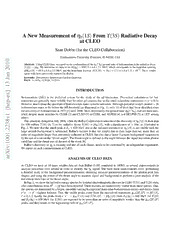
A New Measurement of eta_b(1S) From Upsilon(3S) Radiative Decay at CLEO PDF
Preview A New Measurement of eta_b(1S) From Upsilon(3S) Radiative Decay at CLEO
h ¡ A New Measurement of (1S) From (3S) Radiative Decay b at CLEO Sean Dobbs (for the CLEO Collaboration) NorthwesternUniversity,Evanston,IL60208,USA 0 1 0 Abstract. UsingCLEOdata,wereportontheconfirmationoftheh b(1S0)groundstateofbottomoniumintheradiativedecay 2 ¡ (3S)→gh b.WedetermineitsmasstobeM(h b)=9391.8±6.6±2.1MeV,whichcorrespondstothehyperfinesplitting D Mhf(1S)=68.5±6.6±2.0MeV,andthebranchingfractionB(¡ (3S)→gh b)=(7.1±1.8±1.1)×10−4.Theseresults n agreewiththosepreviouslyreportedbyBaBar. a J Keywords: BottomoniumSpectroscopy,Upsilons,Quarkonia PACS: 14.40.Pq,12.38.Qk,13.25.Gv 3 1 INTRODUCTION ] x e Bottomonium ((cid:12)bb¯(cid:11)) is the preferred system for the study of the qq¯ interaction. Theoretical calculations for bot- - (cid:12) p tomoniumaregenerallymorereliablethanforotherqq¯systemsduetothesmallrelativisticcorrections(v/c≈0.1). e However,muchaboutthespectrumofbottomoniumstatesremainsunknown.Althoughpotentialmodelspredict∼26 h bottomoniumstatestoliebelowtheBBthreshold(asillustratedinFig.1),only10ofthemhadbeenidentifiedsince [ thediscoveryofbottomoniumin1977[1]until2008.Mostimportantly,thegroundstateh b(11S0),hadnotbeeniden- 1 tified,despitemanysearchesbyCUSB[2]andCLEO[3]atCESR,andALPEH[4]andDELPHI[5]atLEP,among v others. 8 ThissituationchangedinJuly2008,whentheBaBarCollaborationannouncedthediscoveryofh (1S)intheirdata b 3 for109million¡ (3S)[6, 7] in theradiativedecay¡ (3S)→gh (1S),witha significanceof>10s ,asillustratedin 2 b 2 Fig.2.WenotethatthesmallpeakatEg ≈920MeVduetotheradiativetransitiontoh b(1S)isnotvisibleuntilthe . large smooth backgroundis subtracted. BaBar’s success is due not simply due to their large data set, more than an 1 orderofmagnitudelargerthanpreviouslycollectedatCLEO,butalsodueafactor3greaterbackgroundsuppression 0 bytheuseofacutonthe“thrustangle”.Thethrustangleisdefinedastheanglebetweenthesignaltransitionphoton 0 1 candidateandthethrustaxisoftherestoftheevent[8]. v: BaBar’sdiscoveryofh b isexcitingandlikeallsuchclaims,needstobeconfirmedbyanindependentexperiment. WereportonsuchameasurementatCLEO. i X r a ANALYSISOF CLEO DATA At CLEO we have an 18 times smaller data set than BaBar (5.9Mcomparedto 109M),so severalimprovementsin analysis procedure were needed in order to identify the h signal. The three main improvementswere: performing b a detailed study of the background parameterization; obtaining accurate parameterizations of the photon peak line shapes;andusingthepowerofthe thrustangleto separatesignalandbackgroundto performa jointanalysisof the fulldatainthreebinsofthethrustangle. InFig.2,weshowtheinclusiveenergyspectraforisolatedelectromagneticshowersinCLEO¡ (3S)and¡ (2S)data, aftercontributionsfromp 0→gg havebeenrejected.Threefeaturesareimmediatelyvisiblefromthesespectra.One, thespectraaredominatedbyalarger,smoothlyvaryingbackgroundfromotherbottomoniumdecaysanddecaysfrom e+e− →g ∗ →lighter hadrons. Two, the visible peaks come from the unresolved transitions c (2P,1P)→g ¡ (1S), bJ J=0,1,2.Lastly,thepeaksfrome+e−→gISR¡ (1S)and¡ (3S,2S)→gh b(1S)(withEg(h b)≈600MeVfor¡ (2S) andEg(h b)≈920MeVfor¡ (3S))areexpectedtobemorethananorderofmagnitudeweakerthanthe c bJ(2P,1P) peaks,andtheyresideonthehighenergytailsofc (2P,1P). bJ FIGURE1. Spectrumof thebound bottomonium (bb¯)states. TheM1 transitionsfromthe¡ (n3S1) statestotheh b(11S0) are indicatedbyredarrowsforthetransitionsreportedinthispaper. ·· 110033 05 GeV )05 GeV ) 550000 (a) 5 GeV) 5 GeV) 110088000000000000 (b) Entries / ( 0.0Entries / ( 0.0 234234000000000000 Entries/ (0.00Entries/ (0.00246246000000000000000000 110000 00 --22000000 00 00..55 00..66 00..77 00..88 00..99 11 11..11 00..55 00..66 00..77 00..88 00..99 11 11..11 EEgg ((GGeeVV)) EEgg ((GGeeVV)) FIGURE2. BaBarresultsfortheobservationofh [6].(Left)Theobservedinclusivephotonspctrum.(Right)Thebackground b subtractedphotonspectrum.Thepeaks,fromlefttoright,arefromc bJ,¡ (1S)ISR,andh b. PhotonLineShapes:Photonlineshapesincrystalcalorimeters,likethoseusedbyCLEO,aregenerallyparame- terizedintermsoftheCrystalBallfunction.ThisfunctioncombinesaGaussian(widths ),withalow-energypower lawtail(parametersa andn).Knowingtheshapeofthelowenergytailisespeciallyimportantforthec peaks,since bJ theyareimportantin determingtheshapeof thebackgroundatthe energyof thesmallh signal.These parameters b must be determined by fitting a background-freephoton peak. In our analysis we use two independentmethods. In one method, we use the observed shape of photons from a given energy from radiative Bhabha events, and in the otherweusetheshapeofphotonsfromtheexcusivedecaysc (2P,1P)→g ¡ (1S), ¡ (1S)→l+l−.Bothmethodsgive b1 consistentresults,andoncetheparametersaredetermined,theyarefixedinsubsequentanalyses. ISR Peak:All the parametersof the ISR photonpeakfrom¡ (nS)→g ¡ (1S)were fixed. Theyield of the ISR ISR peakwasestimatedbyextrapolatingtheobservedyieldinCLEOdatatakenat¡ (4S),andwasthenfixedtothisvalue. Background:We find that fitting the smooth backgroundis the most crucialcomponentin determingthe results for the weak h peak. We made severalhundredbackgroundfits to the data in each of three binsof |cosq |, using b T exponentialpolynomialsof various orders (2,3,4), in various energy regions(500–1340MeV), and with linear and logarithmicbinningofthedata.Wefoundthatmanyofthesefitthedataacceptably,andtookasourfinalresultsthe averageofEg(h b),B(¡ (nS)→gh b),andsignificanceforallthegoodfits(CL>10%).Ther.m.s.variationofthese fitswasthentakenasameasureofthesystematicuncertaintyintheresultsfromthissource,±1MeVinEg,±10%in B(h ),and±0.4s insignificance. b · 103 ·103 V V 0 Me400 U (3S) DATA 0 Me500 U (2S) DATA unts/1330500 U (2Sfi) c bJ(1P) unts/1400 c bJ(1P) o o C250 C 300 200 150 c (2P) 200 bJ 100 100 50 0 400 600 800 1000 1200 0 400 600 800 1000 1200 Inclusive E(g ) (MeV) Inclusive E(g ) (MeV) FIGURE3. CLEOinclusivephotonspectrafor(left)¡ (3S)decay,and(right)¡ (2S),illustratingthebroadfeaturesdescribedin thetext. FIGURE4. (Left)Thrustangle|cosq T|distributionfor¡ (3S)dataintheexpectedh bsignalregion,andtheexpecteddistribution fortheh signalfromMCsimulations.(Right)Inclusivephotonspectraforthedatainthethreethrustangleregions,illustrating b theirdifferentsignal/backgroundratios. JointAnalysisinThreeBinsof|cosq |:AsFig.4(left)shows,thedistributionofthrustangle(|cosq |)forthe T T background-dominateddata is strongly peaked in the forward direction, but for the transition photon to the h , the b distributionis expectedto be uniform.Thishappensbecausethe transition photonis uncorrelatedwith the particles produced by the decay of the h , whereas the background photons tend to be correlated with the other particles b producedintheunderlyingevent.Wethereforedefinethreedifferentregionsof|cosq |:regionI(|cosq |=0−0.3), T T regionII(|cosq |=0.3−0.7),andregionIII(|cosq |=0.7−1.0)).Fig.4(right)illustratesthedifferentlevelsof T T signalandbackgroundinthethreeregions. Unlike BaBar, we do notreject eventsin the |cosq |>0.7 region.Instead, we simultaneouslyfit the spectra for T each of the three regions, which lets each region contribute to the total result weighted by its individual signal-to- background. We call this method the “joint fit”. We have analyzed our data by the joint fit method, and also with |cosq |<0.7,forcomparisonwithBaBar’smethod.Wefindthatthejointfitmethodenhancesthesignificanceofthe T h identificationby∼1s . b JOINTFITRESULTS We show a representative fit for the three bins of thrust angle in Fig. 5. The results of the fit are: N(h ) = b 2311±546counts,Eg(h b)=918.6±6.0(stat)MeV,whichcorrespondstothehyperfinesplittingof68.5±6.6MeV, B(¡ (3S)→gh )=(7.1±1.8(stat))×10−4,andsignificance4.1s . b AlthoughwefixG (h )=10MeV,becausethewidthofh isunknownwefindthatthebranchingfractiondepends b b ontheassumedh widthlinearlyasB(¡ (3S)→gh )×104=5.8+0.13(G (h )inMeV).Ourresultsaredominated b b b FIGURE5. Backgroundsubtractedspectraandrepresentativefitresultfor¡ (3S)→gh b(1S).Theh b(1S)peakisclearlyvisible in|cosq T|regionIandII. FIGURE6. Backgroundsubtractedspectraandrepresentativefitresultfor¡ (2S)→gh b(1S).Thedashedlinecorrespondstothe 90%CLupperlimitgiveninthetext.Theh b(1S)isnotseeninanyofthethreeregionsof|cosq T|. TABLE1. Systematicuncertaintiesinmeasurementof¡ (3S)→gh b photonenergyandbranchingfractions. Uncertaintyin Source EEEggg (MeV) B(((¡¡¡ (((333SSS)))→→→ggghhh bbb))) Background(fn,range,binning) ±1.0 ±10% PhotonEnergyCalibration ±1.2 — PhotonEnergyResolution ±0.3 ±2% CBandc bJ(2P)Parameters ±0.7 ±8% ISRYield ±0.4 ±3% PhotonReconstruction — ±2% N(¡ (3S)) — ±2% MCEfficiency — ±7% Total ±1.8 ±15% TABLE 2. Summary of h b resultsfrom CLEOand BaBar for hyperfine splitting D Mhf(1S)bb¯ and branchingratio,andcomparisonwiththeoreticalpredictions. D Mhf(1S)bb¯,(MeV) B(¡ (nS)→gh b)×104 significance ¡ (3S)→gh b (CLEO)[9] 68.5±6.6±2.0 7.1±1.8±1.1 4s (BaBar)[6] 71.4+3.1±2.7 4.8±0.5±0.6 ≥10s −2.3 ¡ (2S)→gh b (CLEO)[9] — <8.4(90%CL) — (BaBar)[7] 66.1+4.9±2.0 3.9±1.1+1.1 3.0s −4.8 −0.9 Lattice(UKQCD+HPQCD)[10] 61±14 (TWQCD)[11] 70±5 (Ehrman)[12] 37±8 pQCD(various) 35−100 0.05−25(¡ (3S)) 0.05−15(¡ (2S)) bytheirstatisticaluncertainties;thesystematicuncertaintiesweredeterminedconservativelyandaregiveninTable1. Wefurthernotethatalthoughwequoteanuncertaintyinphotonenergycalibrationof±1.2MeV,theenergiesofthe ISRpeakandthec (2P)centroidagreewiththeirexpectedenergieswithin±0.3MeV. bJ The analysis method described for ¡ (3S) was also used for our ¡ (2S) data. Because the background near the expected¡ (2S)→gh b(1S)signal(Eg ≈610MeV)isapproximately6timeshigherthanthecorresponding¡ (3S)(see Fig.3)transition,noevidencefortheexcitationofh wasobservedinany|cosq | bin,asillustratedin Fig.6.The b T jointanalysisledtoanupperlimitofB(¡ (2S)→gh )<8.4×10−4,at90%confidencelevel. b We summarize our results and compare them to BaBar’s results in Table 2. Both results are in agreement. In Table2wealsolistthetheoreticalpredictionsforhyperfinesplittingandbranchingratio.Thevariouspotentialmodel predictionsvaryoverawiderange.Latticecalculationsforthehyperfinesplittingarealsogiven[10,11,12],which generallyagreewiththeexperimentalresults. REFERENCES 1. S.W.Herbetal.,Phys.Rev.Lett.39,252(1977). 2. P.Franzinietal.,(CUSBCollaboration),Phys.Rev.D35,2883(1987). 3. M.Artusoetal.(CLEOCollaboration),Phys.Rev.Lett.94,032001(2005). 4. A.Heisteretal.(ALEPHCollaboration),Phys.Lett.B530,56(2002). 5. J.Abdallahetal.(DELPHICollaboration),Phys.Lett.B634,340(2006). 6. B.Aubertetal.(BABARCollaboration),Phys.Rev.Lett.101,071801(2008). 7. B.Aubertetal.(BABARCollaboration),Phys.Rev.Lett.103,161801(2009). 8. S.Brandtetal.,Phys.Lett.12,57(1964);E.Farhi,Phys.Rev.Lett.39,1587(1977). 9. G.Bonvicinietal.(CLEOCollaboration),submittedtoPhys.Rev.Let.[arXiv:0909.5474]. 10. A.Grayetal.,(HPQCDandUKQCDCollaborations),Phys.Rev.D72,094507(2005). 11. T.BurchandC.Ehmann,Nucl.Phys.A797,33(2007). 12. T.W.Chiu,T.H.Hsieh,C.H.HuangandK.Ogawa(TWQCDCollaboration),Phys.Lett.651,171(2007).
